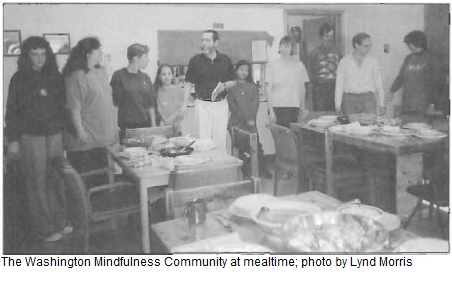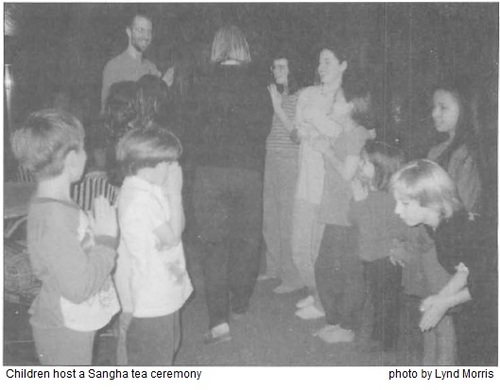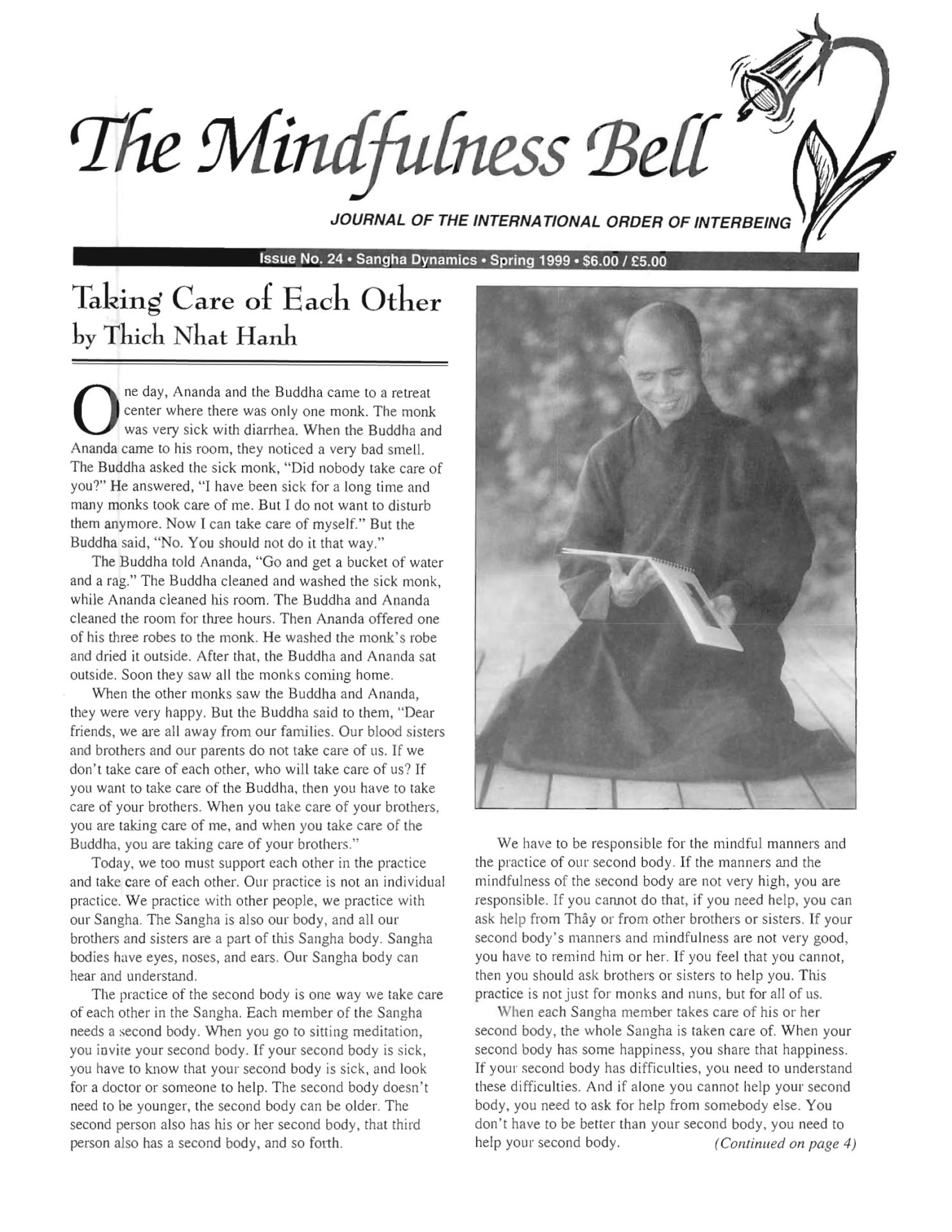By Richard Brady in March 1999
The Washington Mindfulness Community will be ten years old this summer. Our weekly meditations, which drew two to eight people during the early years, now draw thirty to forty. As it has grown, the Sangha’s needs have become more complex and the need for more formal organization greater. Two years ago we decided to incorporate as a nonprofit, and subsequently as a church. The process thus set in motion brought out our diverse views about the nature of our Sangha,
By Richard Brady in March 1999
The Washington Mindfulness Community will be ten years old this summer. Our weekly meditations, which drew two to eight people during the early years, now draw thirty to forty. As it has grown, the Sangha's needs have become more complex and the need for more formal organization greater. Two years ago we decided to incorporate as a nonprofit, and subsequently as a church. The process thus set in motion brought out our diverse views about the nature of our Sangha, whether and how Sangha membership should be defined, how financial, legal, and practice decisions should be made, and what the Sangha's relationship is to the Order of Interbeing.

A year ago, after months of difficult business meetings, impatience, hurt feelings, and Sangha disharmony, I went to Green Mountain Dharma Center in Vermont for a weeklong personal retreat. The snow-covered hills, the still surroundings, and the strong practice of the resident nuns and monks made a profound impression on me. In a couple of days, I succeeded in slowing down my agitated mind and achieved a very welcome sense of peace. Soon enough, however, I would return home.
Before I left Green Mountain, it was my good fortune to have an interview with Sister Annabel. I told her how beneficial my time there had been. Past visits to Plum Village had had similar effect, and I had returned home feeling I had much to share with my family and my Sangha. Each time, however, it was as though I was a tire with a slow leak. Within days, my Plum Village practice leaked away, and I was caught up in my old patterns. As I prepared to leave Green Mountain, I was afraid that the same fate awaited me.
Sister Annabel smiled. "Richard, you know that this is the practice of the present moment. When you are at Green Mountain, you are doing Green Mountain practice, conditioned by all the things you find here and many others including what you bring with you. When you go home, you will be doing the practice that is there for you. Don't expect to continue doing Green Mountain practice at home. The conditions at home are perfect for the practice there."
At home a few days later, I sat on my zafu for the first time. Almost immediately self-doubt, self-criticism, and other negative feelings and thoughts arose. "This is practice at home," I thought. I smiled and watched without getting hooked by it.
Sister Annabel's words apply to practice in the Sangha as well. Sangha practice is made of many elements. Whatever comes up for us in Sangha practice is important. If we are open, our Sanghas will teach us. The lessons for "oldtimers" tend to be different from those for the newcomers. The former often tend to be about living in community, and responding compassionately to hurt, impatience, and disharmony.
In reply to my concerns about Sangha difficulties, Svein Myreng recently said, "It seems to happen everywhere, or almost everywhere, when people get to know each other better. Perhaps it is a sign of maturation rather than a problem, although it can be quite painful. Sometimes the only thing we can do is to be patient and humbly accept the lesson. Though we can try to change situations, mainly through communication, we can't really try to change people. Our main duty is to deepen our own practice as much as possible, and see what comes out of that."
One thing that came from deepening my own practice over the years was the revelation that I didn't know most of my Sangha brothers and sisters very well. Two years ago, I started inviting different people to lunch. Typically, we began talking about our practices and our relationships to the Sangha. Eventually, we brought up personal histories that shaped who we are. We were also able to share and listen to our differing perceptions of the Sangha in a more sensitive way than seemed possible in Sangha business meetings. These opportunities have deepened my understanding and appreciation of many Sangha members, which, in turn, has helped me weather Sangha tensions with more equanimity.
In our Sangha, questions related to practice have been a particular source of tension. The WMC meets from 7:00 to 9:15 Sunday evenings. For years, with a few exceptions, we have done the same thing in these hours. Some sisters and brothers returned from Plum Village and Thay's United States retreats feeling that practice like Touching the Earth and guided meditation would enhance our Sangha experience. Their suggestions met resistance from others who felt things were fine as they were. Using our consensus decision-making process, the Sangha could not agree on any specific changes in Sangha practice or on the creation of a proposed Practice Committee of senior Mindfulness practitioners. However, the practice question was brought to two Sunday meditation evenings, where those present reflected on what they appreciated and desired in Sangha practice.
Recently, we began bimonthly practice forums-meetings open to anyone concerned about Sangha practice issues. They provide an opportunity to look deeply together at the needs of the Sangha. The first meeting was small, but productive. It had become clear that many experienced Sangha members wanted more opportunity to deepen their practice with the Sangha. So the forum agreed to recommend to the next business meeting that the Sangha sponsor an eight-session mindfulness practice course, using Andrew Weiss' recently printed text. The recommendation was approved. The class, composed of five Order of Interbeing members and several other experienced practitioners, has just started, but already seems likely to make an important contribution to Sangha practice. The WMC has faced a number of other difficult issues over the last couple of years. As we tried to absorb the painful leave-taking of a mainstay of our community, and wrote and rewrote our by-laws and articles of incorporation, our personal histories and relationships with other Sangha members sometimes fueled feelings of mistrust and defensiveness, and fears of authority and exclusion. Some Sangha members confided in me about their difficulties with others, but my role as a supportive listener was not lessening tensions. People needed to speak directly with each other from their hearts, if harmony was ever to be achieved.

At our December business meeting, the Sangha invited Ted Cmarada, a mindfulness practitioner and therapist from a neighboring Sangha, to facilitate. Ted quickly saw that bottled-up feelings blocked our really hearing each other, and asked us to share whatever we were holding. Many people spoke straightforwrdly about their problems with the Sangha and with individuals. The meeting was simultaneously painful and inspiring. At its conclusion, the primary criticism of the process was that it had lacked balance. Affirmations had been too few and far between.
Will the Sangha move on to flower watering? Will we develop new by-laws and articles of incorporation which all our members can embrace? Will practice forums become an integral part of Sangha decision making? I don't know. However, I feel some hope. On the door of my refrigerator, I keep a quotation by Vaclav Havel, sent to me by a Sangha member.
Hope is an orientation of the spirit, an orientation of the heart. It is not the conviction that something will turn out well, but the certainty that something makes sense, regardless of how it turns out.
The way our Sanghas are turning out does make sense when we look deeply at the conditions that give rise to them, the people who participate in them, the nutrients our Sanghas ingest, and the seeds they water. The love born of this understanding and nourished by our practice is the greatest contribution we can make to our Sanghas' futures.


